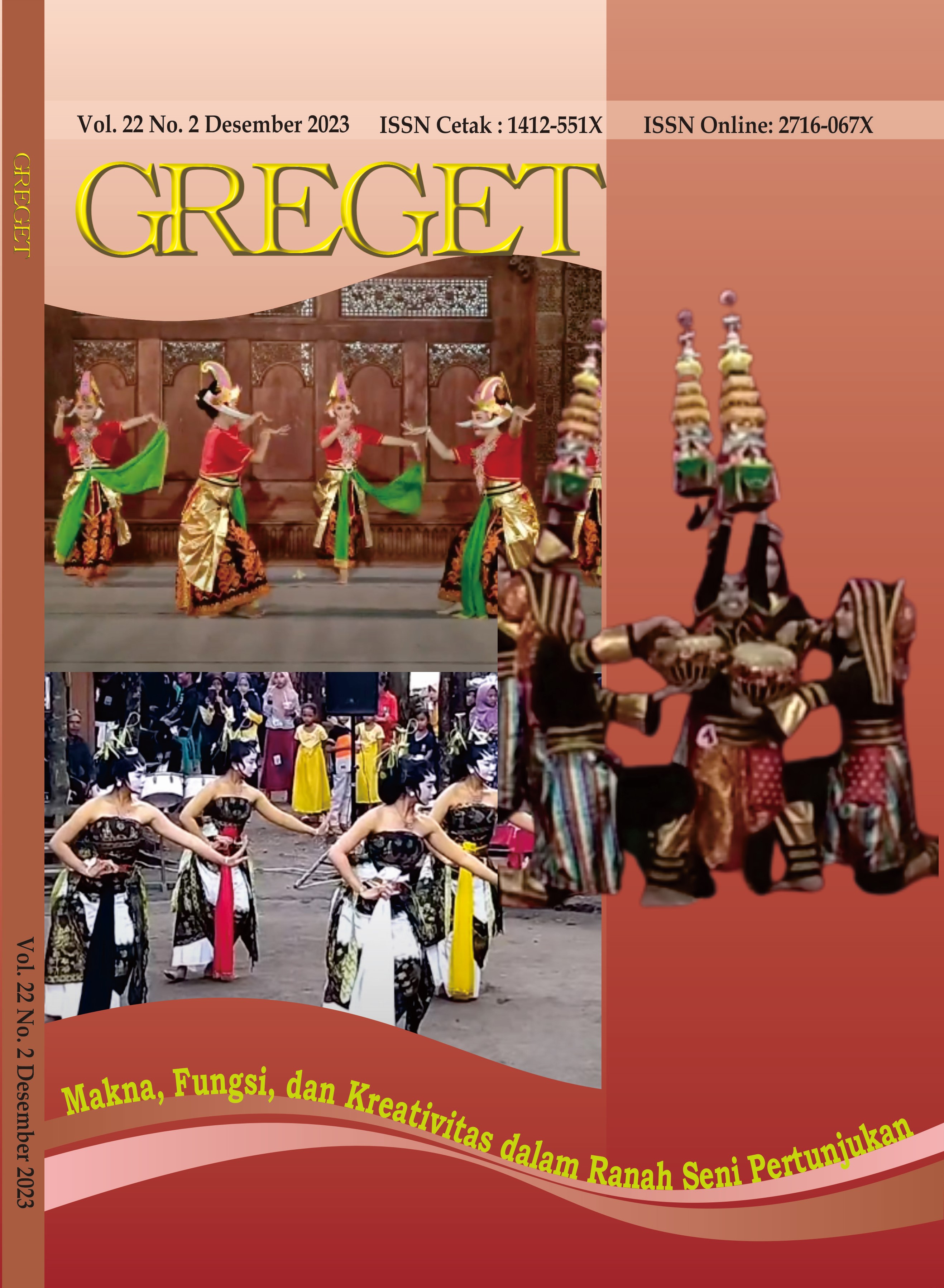MAKNA SIMBOLIK TARI SESANDURAN DI KABUPATEN TUBAN
Main Article Content
Abstract
This research aims to reveal the symbolic meaning that exists in the Sanduran Dance. Sesanduran dance is a dance form inspired by Sandur art in Tuban Regency. Using vocal music and accompanied by roof gongs and drums. This study describes and analyzes about: (1) the form of Sesanduran Dance which includes: movement, dancers, costumes, expressions or feelings, place of performance, (2) describes the symbolic meaning of Sesanduran Dance from the view of inner and outer aspects. To answer the form of Sesanduran Dance using theory by Slamet Md. Describing the symbolic meaning of Sesanduran Dance using theory from Allegra Fuller Synder. This research is a descriptive qualitative research. Data collection through documentation of works, literature studies, interviews and observations of Sandur and Sandur Dance. The results of this study show that the form of dance cannot be separated from the dance former consisting of movement, dancers, costumes, expressions or feelings, the place of performance. The symbolic meaning of Sesanduran Dance is seen from the outside aspect looking at the expression side of society. The compiler of Sesanduran Dance was inspired by the bancik scene in Sandur art in Tuban Regency. This section gives the understanding that humans in their lives are full of journeys that must be passed according to the cycle of life. There are nine motion motives that undergo levels of stimulation, transformation, and unity. Seven sets of motion are the foothold of bancik scenes and two motion motifs are typical movements of Sandur art in Tuban Regency.
Downloads
Article Details

This work is licensed under a Creative Commons Attribution-ShareAlike 4.0 International License.
Copyright
Authors who publish with GREGET agrees to the following terms:
- Authors retain copyright and grant the journal right of first publication with the work simultaneously licensed under a Creative Commons Attribution-ShareAlike 4.0 (CC BY-SA 4.0) that allows others to share the work with an acknowledgment of the work's authorship and initial publication in this journal.
- Authors are able to enter into separate, additional contractual arrangements for the non-exclusive distribution of the journal's published version of the work (e.g., post it to an institutional repository or publish it in a book), with an acknowledgment of its initial publication in this journal.
- Authors are permitted and encouraged to post their work online (e.g., in institutional repositories or on their website) prior to and during the submission process, as it can lead to productive exchanges, as well as earlier and greater citation of published work.
References
Agustin, W. D. S. (2019). Makna Simbolis Tari Mayang Rontek di Kabupaten Mojokerto. Skripsi Jurusan Tari Institut Seni Indonesia Surakarta.
Bandem, I. M. (2000). Etnologi Tari Bali. Kanisius.
Budi, E. (2017). Makna Simbolik Tari Macanan dalam Barongan Blora. Tesis Program Studi Penciptaan dan Pengkajian Seni Intitut Seni Indonesia Surakarta.
Fanny, R. (2021). Proses Kreatif Penciptaan Tari Lencir Kuning karya Sumardi. Skripsi Jurusan Tari Institut Seni Indonesia Yoyakarta.
Hadi, S. Y. (2016). Seni Pertunjukan dan Masyarakat Penonton. Cipta Media.
Kasim, A. (1981). Teater Rakyat di Indonesia. Departemen Pendidikan dan Kebudayaan.
Kasim, A. (2006). Mengenal Teater Tradisional di Indonesia. Dewan Kesenian Jakarta.
Maryono. (2015). Analisa Tari. ISI Press Surakarta.
Murgiyanto, S. (1983). Koreografi: Pengetahuan Dasar Komposisi Tari. Direktur Jendral Pendidikan Dasar dan Menengah Departemen Pendidikan dan Kebudayaan.
Padmodarmaya, P. (1987). Tata dan Teknik Pentas. Balai Pustaka.
Pramutomo, R. M. (2007). Etnokoreologi Nusantara. ISI Press.
Pravitasari, G. L. (2020). Makna Simbolis Tari Jaro Rojab di Kecamatan Wangon Kabupaten Banyumas. Skripsi Jurusan Tari Institut Seni Indonesia Surakarta.
Prihatini, N. S. (2007). Dolalak Purworejo. ISI Press Solo.
Pujilestari, S. (2018). Makna dan Fungsi Tari Kayon Astadala dalam Ritual Upacara Ritual Tawur Kesanga di Dusun Ringintelu Blitar. Skripsi Jurusan Tari Institut Seni Indonesia Surakarta.
Royce, A. P. (2007). Antropologi Tari (F. X. Widaryanto Penerj.). Sunan Ambu Press.
Slamet. (2014). Barongan Blora Menari di Atas Politik dan Terpaan Zaman. Citra Sains.
Slamet. (2016). Melihat Tari. Citra Sain.
Soedarsono. (2000). Metodologi Penelitian Seni Pertunjukan dan Seni Rupa. MSPI.
Soedarsono. (1978). Pengantar Pengetahuan dan Komposisi Tari. ASTI Yogyakarta.
Solikha, I. (2017). Transformasi Tokoh Cawik dalam Kesenian Sandhur pada Tari Lencir Kuning di Kecamatan Semanding kabupaten Tuban. Skripsi Jurusan Sendratasik Universitas Negeri Surabaya.
Sulianto, F. (2015). Teknik Meracik Warna dan Koreksi Pixel. CV Andi OFFSET.
Tyas, G. H. M. (2020). Bentuk dan Fungsi Sandur di Desa Sukorejo Kecamatan Parengan Kabupaten Tuban. Skripsi Jurusan Tari Institut Seni Indonesia Surakarta.
Widyastutieningrum, S. R., dan Wahyudiarto, D. (2014). Pengantar Koreografi. ISI Press.
